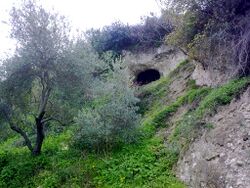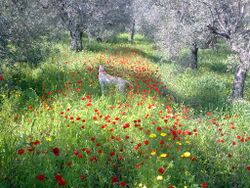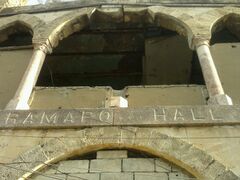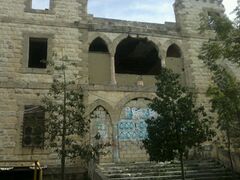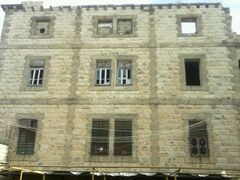المية ومية
المية ومية | |
|---|---|
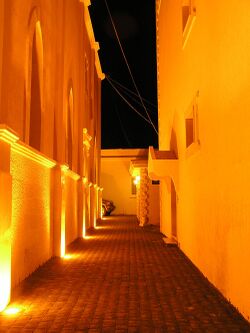 | |
| الإحداثيات: 33°32′31″N 35°23′51″E / 33.54194°N 35.39750°E | |
| Country | |
| Governorate | South Governorate |
| District | Sidon District |
| الحكومة | |
| • النوع | Mayor–council |
| • الكيان | Miye ou Miye municipality |
| • De Facto Mayor | Nicola Bou Daher |
| المساحة | |
| • الإجمالي | 5٫05 كم² (1٫95 ميل²) |
| أعلى منسوب | 208 m (685 ft) |
| أوطى منسوب | 29 m (95 ft) |
| منطقة التوقيت | UTC+2 (EET) |
| • الصيف (التوقيت الصيفي) | UTC+3 (EEST) |
| Dialing code | 00961 (7) Landline |
| الموقع الإلكتروني | www |
المية ومية أو الميّه و ميّه هي احدى القرى اللبنانية من قرى قضاء صيدا في محافظة الجنوب. تقع قرية الميّه و ميّه أو المية ومية (Mieh W Mieh - Mieh Mieh) في منطقة شرقي صيدا, قضاء صيدا في محافظة جنوب لبنان و هي ترتفع 200 متر عن سطح البحر و تبعد ثلاث كيلومترات عن عاصمة الجنوب اللّبناني.
أصل الاسم
قد يكون اسمها مشتقًّا من كلمة مومياء و هو اسم سريانيّ الأصل و قد تحوّل الأسم تدريجيًّا إلى ميومية إلى أن انتهى إلى ما هو عليه اليوم.و يقال أنه في أثناء إجراء إحصاء لعدد القرى في إقليم التفاح وقبل الوصول إلى البلدة كان العدد 199 وكان يفترض أن يكون رقم البلدة 200 لكنها أعطيت الرقم 100 و100 وعرفت لاحقاً بميّة وميّة (و من باب التّندّر يقال أنها القرية ال 200 التي احتلها نابوليون بونابارت بعيد غزوة عكا و لكن ليس هناك من شاهد تاريخي على هذه المقولة).
- It also comes from the Arabic language meaning “mieyya ”, which means one hundred. During a census of the number of villages that the Druze won in war during the 1800s in the Iqlim al-Tuffah; Miye ou Miye the village, was number 200 on the roster. They presented their winnings in a batch format of 100. We won "mieyya" and this is the second "mieyya". So, it was named Miye ou Miye.[بحاجة لمصدر]
- Due to abundance of water in the area, the village was named Mayya w Mayya, meaning water and water in Assyrian.[بحاجة لمصدر]
السكان
Miye ou Miye’s population prior to 1985, which is when the town was attacked during the civil war, was around 5000+ inhabitants. Due to the displacement by the civil war; about half the population migrated to Western countries, about a quarter moved to the capital, Beirut, and the rest returned and settled in Miye ou Miye. Miye ou Miye is a Christian village. The people of Miye ou Miye are mostly members of the Melkite Greek Catholic Church (85%),[1] with a few Maronites (7%), Protestants (6%), and Baptists (2%). The population of the town doubles when the immigrants / expatriates return to spend their summer vacations in their ancestral home. Arabic is the official language; English and French are also spoken.[بحاجة لمصدر]
Neighborhoods
- Aawad
- Achrafieh Downer
- Achrafieh Upper
- Ain Zaytoun
- Ataaht
- Beaula
- Chaby
- Church
- El Aarid
- El Aayar
- El Bir (Bir Toufic)
- El Birki
- El Byader
- El Furn
- El Hirish
- El Houch
- El Khaly
- El Khirby
- El Mahafar
- El Roos
- El Sahle
- Jel El Taweel
- Jel El Aajil
- Jel El Aqil
- Jel El Achkar
- Jelali El Aabdy
- Jib El Houn
- Jlaa El Dine
- Jlaly El Aanib
- Karem El Razin
- Karm El Sowan
- Khandaq El Wawoeeyah
- Khlali
- Mghariq
- Nabaat Mar Giryos
- Sbeil
- Skaykini
- Tourbit Shiry
التاريخ
In the 17th century, Miye ou Miye was mostly farmland owned by a number of wealthy families. The families of "Abu Nakad" and "Faddoul" owned half of the land and the state owned the rest. In the 18th century, Christians started to move to the village, and the state encouraged the farmers by giving them land to farm. The farmers in return had to pay back 10% of the crops.[2] In 1875 Victor Guérin found the village to have 400 inhabitants, some Maronites and some Greek Orthodox.[3]
In the 19th century, American missionaries came to the village for missionary work. In 1985, the Lebanese Civil War spread to South Lebanon, and the villagers fled for their safety farther south and others went to the capital. From there they started their journey abroad to over 26 countries. The majority went to the United States of America, Canada, and Australia. In August 1991, the Miye ou Miye refugees returned and started rebuilding the village that was destroyed completely. Today, Miye ou Miye is full of life and it became better than it was before the war. Immigrants, who are living away from their hometown, carried their little town in their hearts along with deep pride of their heritage. This deep love and passion guided them in their daily lives and provided a moral compass.[بحاجة لمصدر]
The Miye ou Miye population includes the following families: [4]
- Abdallah
- Abou Zeid
- Abou Chaar
- Andraos
- Asaad
- Bou Saba
- Chemali
- Costantin
- Francis
- Ghassan
- Haikal
- Hayek
- Jabbour
- Khoury
- Kozhaya
- Makhoul
- Matta
- Moussa
- Najem
- Saikaly
- Saliba
- Semaan
- Stephan
- Wakim
Culture and art
- Every year in the middle of July, Arine Sports Club (العربية: نادي العرين الرياضي) and Miye ou Miye municipality hold a two-week athletic festival that includes games, tournaments, and other live events called "Karmes" or Carnaval. The games are played at Nasri Wakim arena, located in the middle of town in Beaula neighborhood. In addition, the World Vision International sponsored a library in town, which has enhanced the capabilities of, and resources for students; the youth, as well as adults. Also, an infirmary or a clinic is located in town to provide medical care mainly to the elderly. This invaluable service provided easy, walking distance access for the town's elderly.[بحاجة لمصدر]
- It is worth mentioning that Miye ou Miye had a renowned artist, who was a painter and a sculpture. Mr. Rashid Gerges Semaan, studied art in the most prestigious art institutes in Italy, graduated with high honors and returned to his native hometown to serve his community and his country. He sculpted several famous statues, most notably was the statue of the late Egyptian President Gamal Abdel Nasser, Maarouf Saad, and Motherhood (العربية: الامومة). Mr. Semaan was known as a passionate artist and poet who transformed a dull concept into a charming, beautiful, and seductive form of artistic beauty. Currently, the town boasts two professional individuals who are trailing blazers in the beauty of art and literature: Dr. Mounif Moussa and Hannah Shakeeb Bousaba.[بحاجة لمصدر]
الاقتصاد
Miye ou Miye's main industry is agriculture. The town produces olive oil, edible olives, figs, and loquat (acadinia, pi-pa, mespila). Some olive trees date back to the Ottoman Empire days, while others date back to the era of Prince Fakhr-al-Din II Al-maani Al Kabiir. Livelihood from agricultural and farming products dwindled with time. The younger generation focused their energy on higher education where a new crop of professionals has emerged such as: doctors, business owners, dentists, lawyers, engineers, etc.[بحاجة لمصدر]
Over the years, Miye ou Miye has provided its fair share of soldiers and officers to the country they all love and adore. They wore the uniform with pride and some made the ultimate sacrifice for their country.[بحاجة لمصدر]
منظر بانورامي
التعليم
- National Evangelical School for Girls and Boys
- Miye ou Miye High School
الصحة
- Miye ou Miye Clinic
- Hariri Clinic
- Sidon Governmental Hospital
- El Hamshary Hospital
Institutions
- Arine Sports Club
- Miye ou Miye Senior's Club
- Officer's Military Club & Compound
Landscape
Landscape in Miye ou Miye Matthews Vegetation Zone: evergreen broadleaved shrub land/thicket and evergreen dwarf shrub land. The soil type: luvisols, cambisols (LV), soil with clay-enriched lower horizon, high CEC, and high saturation bases. There is no malaria occurrence. Miye ou Miye is in a very strong (vii) earthquake zone on average one every 50 years, with occurrences of earthquakes at 6-7 Richter scale. There is a medium to high occurrence of flooding with a risk factor of 7 out of 10. Also, drought is an issue in the town with a risk factor of 9 out of 10.[5]
Weather
Miye ou Miye experiences temperate climatic conditions with clearly defined seasons. Summers are hot and dry, while winters are cold and wet. The temperatures in Miye ou Miye are considered mild and humid climate. Summer spans the months of June to September and is the most popular time to visit, with temperatures peaking in July and August. At their hottest, summer days reach about 31 °C ( 88 °F) and occasional heat weave conditions. Winter takes charge from December to March and during this time, Miye ou Miye sees a great deal of rain. Winter conditions are much milder with the mercury rarely dropping below 11 °C (52 °F). Spring and fall are pleasant as the weather is warm but not unbearable.
Miye ou Miye, experiences شلوق shlūq winds (also known as Sirocco in Europe and Khamaseen in Northern Africa). These winds are most common during autumn and spring seasons. Shlūq winds are red Sahara dust and is associated with storms and heavy rain, the wind being very strong, the duration may be as short as half a day or may last several days (usually four days).
| بيانات المناخ لـ Miye ou Miye, Lebanon | |||||||||||||
|---|---|---|---|---|---|---|---|---|---|---|---|---|---|
| الشهر | ينا | فب | مار | أبر | ماي | يون | يول | أغس | سبت | أكت | نوف | ديس | السنة |
| متوسط القصوى اليومية °س (°ف) | 12.0 (53.6) |
16.0 (60.8) |
19.0 (66.2) |
22.0 (71.6) |
26.0 (78.8) |
27.0 (80.6) |
29.0 (84.2) |
29.0 (84.2) |
29.0 (84.2) |
25 (77) |
19.0 (66.2) |
13.0 (55.4) |
22.2 (71.9) |
| متوسط الدنيا اليومية °س (°ف) | 9.0 (48.2) |
12.0 (53.6) |
16.0 (60.8) |
19.0 (66.2) |
23.0 (73.4) |
24.0 (75.2) |
26.0 (78.8) |
25 (77) |
26.0 (78.8) |
21.0 (69.8) |
16.0 (60.8) |
10 (50) |
18.9 (66.1) |
| متوسط تساقط الأمطار mm (inches) | 305 (12.02) |
125 (4.91) |
31 (1.21) |
89 (3.52) |
31 (1.21) |
15 (.59) |
0 (0) |
0.51 (.02) |
1.5 (.06) |
120 (4.8) |
51 (2.02) |
215 (8.47) |
986 (38.83) |
| Average precipitation days (≥ 0.25 mm) | 16 | 11 | 8 | 13 | 19 | 9 | 0 | 2 | 2 | 18 | 15 | 22 | 135 |
| متوسط الرطوبة النسبية (%) | 77 | 63 | 59 | 58 | 53 | 61 | 60 | 66 | 61 | 59 | 60 | 77 | 63 |
| Mean monthly ساعات سطوع الشمس | 142 | 159.5 | 239 | 307 | 335 | 346.5 | 387.5 | 384.5 | 303 | 250 | 194.5 | 129 | 3٬177٫5 |
| Source: World Weather Online,[6] | |||||||||||||
Parks and recreation
Miye ou Miye Park was created in 2001.[بحاجة لمصدر]
Byader Park is used for religious activities and athletic events. This land used to be owned by several farmers’ families. At this location the farmers used to beat the head of the wheat stalk with a club like tool to loosen the grain, then throw it into the air. The lighter chaff material blew away further on the ground than the grain which was heavier. The grain was then collected and sold at the local mill. Over the years, they donated their ownership in this land to the interest of the town.[بحاجة لمصدر]
Religious & historical Sites
Saint Georges Spring (Nabaat Mar Giryos)
A shepherd from the village had several different dreams during a period of time. Always in these dreams, a knight (ref: rider, Saint George) was riding a white horse, while the shepherd was herding his sheep. In each dream, the knight told the shepherd to tell the mayor and the priest of the village to dig in this particular spot (33°32′45.00″N 35°23′16.98″E / 33.5458333°N 35.3880500°E) and your town will have a natural water spring. And the rider added, in case the people in town did not believe you; take this olive branch with fruits on it as a proof. When this event occurred, the harvest of the olive fruit was long gone. The people of the village did not believe the shepherd at first, until he showed them the olive branch with the fruits on it. They dug where Saint Georges pointed, and water came out. St. Georges Natural Spring became a holy place and is called in Arabic “Nabaat Mar Giryos". The natural spring became the destination for many people, mainly for praying and healing. The elderly in the village are still telling this story from generation to generation. Unfortunately, after the civil war in 1985 in Miye ou Miye and the displacement of the town's people, the St. George's natural spring was bulldozed and covered with dirt and debris.[7]
Ramapo Hall
National Evangelical Institute for Girls and Boys is one of the National Evangelical Synod Schools in Lebanon. It is a private school and the union of two old and historical famous institutions: Sidon Evangelical School for Girls (SESG) that was first founded in 1862 and Gerard Institute for the boys that was first founded in 1881 by the missionaries Rev. William King Eddy and Dr. George Ford.[8] Dr. Ford had a grander vision of building an orphanage and other facilities in Miye ou Miye hilltop overlooking the ancient city of Sidon. But since he was in need of funds to build it, he traveled to Ramapo, New York, and secured donations from the local Christian community. The word Ramapo (Ramapough), is from Native American origin, meaning either "sweet water" or "sloping/slanting rocks". In 1881, with the donation money secured, he built Ramapo Hall, Peace Hall, among other buildings in Miye ou Miye. During World War II, the Australian 7th Division,[9] with British and Free French, supported by the Royal Australian Air Force, Royal Australian Navy, Royal Navy and Royal Air Force, fought for Miye ou Miye against Vichy French forces in 1941. The Free France Forces turned the orphanage into a prison when they defeated the Vichy French. In 1942-43, the Lebanese people strived for independence from the French control. The French authorities responded by arresting and imprisoning key Lebanese leaders at Ramapo hall. Lebanese Christian and Muslim leaders united their forces, supported by the international community and regional powers, to pressure the French government which resulted in releasing the prisoners on November 22, 1943 and recognizing Lebanon's full and complete independence.[10] In 1948, Palestinian refugees were driven from their homeland during the Israeli-Palestinian conflict and some of them settled at the outskirts of Miye ou Miye, occupying the land and the Palace(Ramapo Hall). Since then, the West of Miye ou Miye village became known as Mieh Mieh refugee camp. Also, below the hill of Miye ou Miye refugee camp another camp was created at that time and became known as Ain al-Hilweh Palestinian refugee camp.[بحاجة لمصدر]
References
- ^ "Miyeh ou Miyeh - Localiban".
- ^ "Mieh Mieh". Archived from the original on 2013-04-21. Retrieved 2012-12-10.
- ^ Guérin, 1880, p. 513
- ^ Localiban list of names of registered voters
- ^ "Archived copy". Archived from the original on 2016-03-03. Retrieved 2012-12-08.
{{cite web}}: CS1 maint: archived copy as title (link) - ^ "World Weather Online". Retrieved 2019-01-03.
- ^ http://www.miehwmieh.com/stgeorges.html
- ^ "Sidon National Evangelical Institute - "The American School" - Mieh w Mieh".
- ^ "2/27th Australian Infantry Battalion".
- ^ "History of Lebanon, Ottomans- French- Independence 1516-1943".
Bibliography
- Guérin, V. (1880). Description Géographique Historique et Archéologique de la Palestine (in French). Vol. 3: Galilee, pt. 2. Paris: L'Imprimerie Nationale.
{{cite book}}: CS1 maint: unrecognized language (link)
وصلات خارجية
- الموقع الرّسمي الجديد للميّه و ميّه
- موقع أبناء الميّه و ميّه في الإغتراب
- الموقع الرّسمي لقرية الميّه و ميّه
- صور قديمة من بلدة الميّه و ميّه في موقع المشرق
- صور من الميّه و ميه
- صور من الميّه و ميه
مصادر
- موقع لوكاليبان
- Miyeh ou Miyeh, Localiban

|
عين الدلب | حارة صيدا | 
| |
| القرية | صيدا | |||
| درب السيم، زغدريا |

